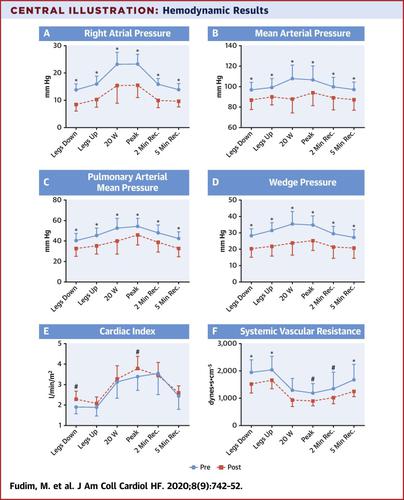JACC: Heart Failure ( IF 13.0 ) Pub Date : 2020-06-10 , DOI: 10.1016/j.jchf.2020.04.010 Marat Fudim 1 , Richard L Boortz-Marx 2 , Arun Ganesh 2 , Adam D DeVore 1 , Chetan B Patel 3 , Joseph G Rogers 1 , Aubrie Coburn 3 , Inneke Johnson 3 , Amanda Paul 3 , Brian J Coyne 3 , Sunil V Rao 1 , J Antonio Gutierrez 3 , Todd L Kiefer 3 , David F Kong 1 , Cynthia L Green 4 , W Schuyler Jones 1 , G Michael Felker 1 , Adrian F Hernandez 1 , Manesh R Patel 1

|
Objectives
We hypothesized that splanchnic nerve blockade (SNB) would attenuate increased exercise-induced cardiac filling pressures in patients with chronic HF.
Background
Chronic heart failure (HF) is characterized by limited exercise capacity driven in part by an excessive elevation of cardiac filling pressures.
Methods
This is a prospective, open-label, single-arm interventional study in chronic HF patients. Eligible patients had a wedge pressure ≥15 mm Hg at rest or ≥25 mm Hg with exercise on baseline right heart catheterization. Patients underwent cardiopulmonary exercise testing with invasive hemodynamic assessment, followed by percutaneous SNB with ropivacaine.
Results
Nineteen patients were enrolled, 15 of whom underwent SNB. The average age was 58 ± 13 years, 7 (47%) patients were women and 6 (40%) were black. Left ventricular ejection fraction was ≤35% in 14 (93%) patients. No procedural complications were encountered. SNB reduced mean pulmonary arterial pressure at peak exercise from 54.1 ± 14.4 (pre-SNB) to 45.8 ± 17.7 mm Hg (p < 0.001) (post-SNB). Similarly, SNB reduced exercise-induced wedge pressure from 34.8 ± 10.0 (pre-SNB) to 25.1 ± 10.7 mm Hg (p < 0.001) (post-SNB). The cardiac index changed with peak exercise from 3.4 ± 1.2 (pre-SNB) to 3.8 ± 1.1 l/min/m2 (p = 0.011) (post-SNB). After SNB, patients exercised for approximately the same duration at a greater workload (33 ± 24 W vs. 50 ± 30 W; p = 0.019) and peak oxygen consumption VO2 (9.1 ± 2.5 vs. 9.8 ± 2.7 ml/kg/min; p = 0.053).
Conclusions
SNB reduced resting and exercise-induced pulmonary arterial and wedge pressure with favorable effects on cardiac output and exercise capacity. Continued efforts to investigate short- and long-term effects of SNB in chronic HF are warranted. Clinical Trials Registration (Abdominal Nerve Blockade in Chronic Heart Failure; NCT03453151)
中文翻译:

慢性心力衰竭的内脏神经阻滞。
目标
我们假设内脏神经阻滞 (SNB) 会减弱慢性 HF 患者运动引起的心脏充盈压增加。
背景
慢性心力衰竭 (HF) 的特征是运动能力有限,部分原因是心脏充盈压过度升高。
方法
这是一项针对慢性 HF 患者的前瞻性、开放标签、单臂介入性研究。符合条件的患者在基线右心导管插入术时,静息时楔压≥15 mm Hg 或运动时楔压≥25 mm Hg。患者接受了带有侵入性血流动力学评估的心肺运动测试,然后接受了罗哌卡因经皮 SNB。
结果
招募了 19 名患者,其中 15 名接受了 SNB。平均年龄为 58 ± 13 岁,7 名 (47%) 患者为女性,6 名 (40%) 为黑人。14 名(93%)患者的左心室射血分数≤35%。没有遇到任何程序上的并发症。SNB 将运动峰值时的平均肺动脉压从 54.1 ± 14.4(SNB 前)降低到 45.8 ± 17.7 mmHg(p < 0.001)(SNB 后)。同样,SNB 将运动引起的楔形压力从 34.8 ± 10.0(SNB 前)降低到 25.1 ± 10.7 mm Hg(p < 0.001)(SNB 后)。心脏指数随着运动峰值从 3.4 ± 1.2(SNB 前)变为 3.8 ± 1.1 l/min/m 2 (p = 0.011)(SNB 后)。在 SNB 之后,患者在更大的工作量(33 ± 24 W 对 50 ± 30 W;p = 0.019)和峰值耗氧量 V O 2 下锻炼了大约相同的持续时间 (9.1 ± 2.5 与 9.8 ± 2.7 毫升/公斤/分钟;p = 0.053)。
结论
SNB 降低静息和运动引起的肺动脉和楔压,对心输出量和运动能力有有利影响。有必要继续努力研究 SNB 对慢性 HF 的短期和长期影响。临床试验注册(慢性心力衰竭中的腹神经阻滞剂;NCT03453151)


























 京公网安备 11010802027423号
京公网安备 11010802027423号